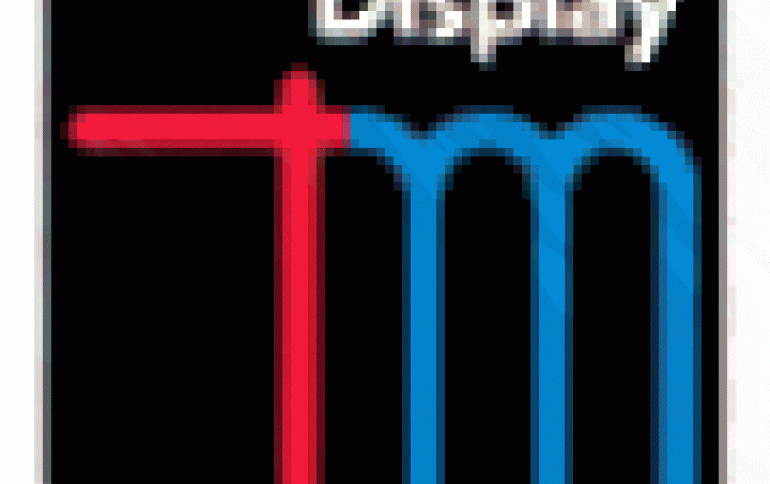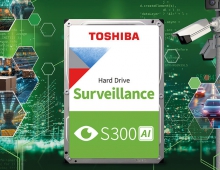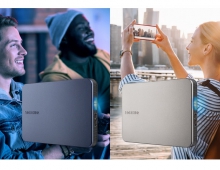
Toshiba To Showcase 3D and Other LCD Technologies at SID
Toshiba will exhibit next-generation displays and technologies developed by Toshiba Mobile Display Co., Ltd. (TMD) for industrial markets, mobile phone and portable electronics, and automotive applications at the 2010 Society for Information Display (SID) International Symposium, Seminar & Exhibition, May 25 to 27, 2010.
Featured developments in TAEC's booth this year include three different 3D technology demonstrations, new displays for high-resolution handheld mobile applications, recently introduced industrial LCD displays with replaceable LED backlights achieving 100,000 hours MTBF, and new high-resolution automotive displays. Displays with Optically Compensated Bend (OCB), Low Temperature Poly-Silicon (LTPS), System-on-Glass (SOG), LED backlighting, and other advanced technologies can be viewed in four demonstration areas: industrial, mobile, automotive, and 3D technology.
3D Technology
TAEC will demonstrate three separate 3D technologies. The first approach, Time Sequential Twin-Eye, will be shown on a 3.0-inch Wide-QVGA (400 x 240) 3D OCB display utilizing a backlight system incorporating a bi-directional lens sheet. This display synchronizes LED switching with left- and right-eye images to achieve stereoscopic (twin-eye 3D) viewing without special glasses while maintaining a fast response time, and a wide viewing angle. This approach is 2D/3D switchable, and enables a thin, easy to assemble LCD panel utilizing its full native resolution.
The second approach, Integral Imaging 3D, uses a lenticular sheet to enable "Multi-view" natural viewing without 3D glasses, so the same image can be seen from multiple viewing points. Integral Imaging will be shown in a 21.0-inch Wide-XGA (1280 x 800) technology demonstration.
A third approach, which uses OCB glasses with time sequential 3D displays to achieve fast response with minimal crosstalk, will be shown in 15.4-inch Wide-XGA (1280 x 800) and 32-inch Wide-XGA (1366 x 768) sizes. This 3D technique alternately displays the appropriate image for each eye while the OCB glasses act as an alternating shutter to achieve a 3D effect without any loss of resolution between the LCD and the image.
Displays for Industrial Applications
A lineup of recently introduced color LTPS active-matrix thin-film transistor (TFT) LCD modules for industrial applications will be shown, which incorporate 100,000 hour MTBF LED backlighting systems designed to satisfy the requirements of a broad range of industrial applications, such as test and measurement equipment, medical equipment, and more. The demonstration includes LCD modules in five screen sizes: 5.7-inch, 6.5-inch, 8.4-inch, 10.4-inch, and 12.1-inch.
Display resolutions are VGA (640 x 480) for the 5.7-inch module and the 6.5-inch module, SVGA (800 x 600) for the 8.4-inch module, and XGA (1024 x 768) for the 10.4-inch and 12.1-inch modules. Each of these modules have replaceable, mercury-free LED-based backlighting systems with 100,000 hour MTBF, which far exceeds that of common TFT LCDs for industrial applications utilizing long-life cold cathode fluorescent lamp (CCFL) backlights.
Additional modules representing TAEC's industrial LCD line include three 100,000 hour MTBF modules with resistive touch panels: 8.4-inch SVGA (800 x 600), 8.4-inch XGA (1024 x 768), and 10.4-inch XGA (1024 x 768) LCD panels, with replaceable LED backlights rated for 100,000 hours MTBF.
"Screen Fit"Technology
TMD will again show its "Screen Fit" optical bonding transparent cover panel technology this year, demonstrating its potential for industrial applications. Screen Fit reduces reflections from the inner surface of the cover panel as well as the reflections from the surface of the LCD panel, utilizing a special resin injected between the cover panel and the polarizer film of the LCD panel, fusing the two together. The resin assures optical integrity between the two materials, minimizes interface reflections and strengthens the module structure. Compared to a conventional LCD design, in which the top polarizer film layer of the display is protected by an acrylic cover panel encasing the hollow space between the cover and the display, a Screen Fit LCD enhances the display's optical characteristics by eliminating two boundaries that reflect and scatter light, reducing reflections. The exhibit shows a 12.1-inch Wide-XGA (1280 x 800) Screen Fit display adjacent to a conventional TN display of the same resolution and form factor to demonstrate the improvements in image quality.
Displays for Mobile Phones and Portable Electronics
The mobile section of the booth will feature high-resolution LTPS displays, up to 367ppi (pixels per inch resolution density), in sizes ranging from 3.3-inch to 4.0-inch with resolution formats ranging from Wide-VGA (480 x 864) to HD (720 x 1280). In addition, these displays will demonstrate advanced technologies such as high-contrast (up to 1,500:1), high-color (up to 92% NTSC), and wide viewing angle (up to H/V 176 degrees /176 degrees ).
Displays for Automotive Applications
High-resolution displays for automotive center information, navigation and entertainment applications are featured this year. On display for the first time in North America, a 7.0-inch high-resolution Wide-XGA (1280 x 720) LTPS TFT module for center information or navigation applications will be shown, along with a 9.0-inch Wide-XGA (1280 x 720) TFT module for HDTV automotive entertainment applications. Two other displays - 4.2-inch Wide-QVGA (400 x 240) for instrument cluster, and 8.0-inch Wide-VGA (800 x 480) for navigation - will be demonstrated as well.
3D Technology
TAEC will demonstrate three separate 3D technologies. The first approach, Time Sequential Twin-Eye, will be shown on a 3.0-inch Wide-QVGA (400 x 240) 3D OCB display utilizing a backlight system incorporating a bi-directional lens sheet. This display synchronizes LED switching with left- and right-eye images to achieve stereoscopic (twin-eye 3D) viewing without special glasses while maintaining a fast response time, and a wide viewing angle. This approach is 2D/3D switchable, and enables a thin, easy to assemble LCD panel utilizing its full native resolution.
The second approach, Integral Imaging 3D, uses a lenticular sheet to enable "Multi-view" natural viewing without 3D glasses, so the same image can be seen from multiple viewing points. Integral Imaging will be shown in a 21.0-inch Wide-XGA (1280 x 800) technology demonstration.
A third approach, which uses OCB glasses with time sequential 3D displays to achieve fast response with minimal crosstalk, will be shown in 15.4-inch Wide-XGA (1280 x 800) and 32-inch Wide-XGA (1366 x 768) sizes. This 3D technique alternately displays the appropriate image for each eye while the OCB glasses act as an alternating shutter to achieve a 3D effect without any loss of resolution between the LCD and the image.
Displays for Industrial Applications
A lineup of recently introduced color LTPS active-matrix thin-film transistor (TFT) LCD modules for industrial applications will be shown, which incorporate 100,000 hour MTBF LED backlighting systems designed to satisfy the requirements of a broad range of industrial applications, such as test and measurement equipment, medical equipment, and more. The demonstration includes LCD modules in five screen sizes: 5.7-inch, 6.5-inch, 8.4-inch, 10.4-inch, and 12.1-inch.
Display resolutions are VGA (640 x 480) for the 5.7-inch module and the 6.5-inch module, SVGA (800 x 600) for the 8.4-inch module, and XGA (1024 x 768) for the 10.4-inch and 12.1-inch modules. Each of these modules have replaceable, mercury-free LED-based backlighting systems with 100,000 hour MTBF, which far exceeds that of common TFT LCDs for industrial applications utilizing long-life cold cathode fluorescent lamp (CCFL) backlights.
Additional modules representing TAEC's industrial LCD line include three 100,000 hour MTBF modules with resistive touch panels: 8.4-inch SVGA (800 x 600), 8.4-inch XGA (1024 x 768), and 10.4-inch XGA (1024 x 768) LCD panels, with replaceable LED backlights rated for 100,000 hours MTBF.
"Screen Fit"Technology
TMD will again show its "Screen Fit" optical bonding transparent cover panel technology this year, demonstrating its potential for industrial applications. Screen Fit reduces reflections from the inner surface of the cover panel as well as the reflections from the surface of the LCD panel, utilizing a special resin injected between the cover panel and the polarizer film of the LCD panel, fusing the two together. The resin assures optical integrity between the two materials, minimizes interface reflections and strengthens the module structure. Compared to a conventional LCD design, in which the top polarizer film layer of the display is protected by an acrylic cover panel encasing the hollow space between the cover and the display, a Screen Fit LCD enhances the display's optical characteristics by eliminating two boundaries that reflect and scatter light, reducing reflections. The exhibit shows a 12.1-inch Wide-XGA (1280 x 800) Screen Fit display adjacent to a conventional TN display of the same resolution and form factor to demonstrate the improvements in image quality.
Displays for Mobile Phones and Portable Electronics
The mobile section of the booth will feature high-resolution LTPS displays, up to 367ppi (pixels per inch resolution density), in sizes ranging from 3.3-inch to 4.0-inch with resolution formats ranging from Wide-VGA (480 x 864) to HD (720 x 1280). In addition, these displays will demonstrate advanced technologies such as high-contrast (up to 1,500:1), high-color (up to 92% NTSC), and wide viewing angle (up to H/V 176 degrees /176 degrees ).
Displays for Automotive Applications
High-resolution displays for automotive center information, navigation and entertainment applications are featured this year. On display for the first time in North America, a 7.0-inch high-resolution Wide-XGA (1280 x 720) LTPS TFT module for center information or navigation applications will be shown, along with a 9.0-inch Wide-XGA (1280 x 720) TFT module for HDTV automotive entertainment applications. Two other displays - 4.2-inch Wide-QVGA (400 x 240) for instrument cluster, and 8.0-inch Wide-VGA (800 x 480) for navigation - will be demonstrated as well.





















